Discover Advanced Photo Restoration & Scanning Techniques
Have you ever wondered what to do with your old photo albums or collection of slides and negatives? If the photos look old or damaged is it even worth trying to resurrect them?

Don’t throw away your old photo albums!
The answer is YES! It’s amazing what’s possible these days with modern scanning technology.
While cheaper ‘consumer’ scanners are often an attractive option due to their lower price and apparent ease of use, they will only produce poor to average results, limited resolution and correction options, and ultimately won’t be doing your images justice.
DO IT ONCE, DO IT RIGHT!
On the other hand, higher end and professional image scanners give great results, allowing you to produce high quality, clear images and utilise the latest in scanning technology. Seeing old family memories come back to life and be preserved for future generations is definitely worth it.
Below I will explain a few ways old slides, photos and negatives can be restored and some of the technology involved.
Resolution and Quality:

left: 35mm Kodachrome slide scanned at 300dpi, right: scanned at 6400dpi (click image for full quality)
The quality of your scanner’s lens and image sensor will play a huge part in determining the quality of the final scan. Obviously, a higher quality scanner that can scan at higher resolutions will produce a better, clearer image than one which can only scan at low resolutions or is of poor overall quality. This is especially important if you are looking to print enlargements down the track.
Image Sharpening:

compare between the standard image (left) and the sharpened version on the right
Sharpening an image will bring out the detail, and can usually be done at different levels depending on the condition of the original. It unfortunately won’t enable you to bring badly out of focus shots back into focus, but really gives a good result at ‘tidying’ the image up. Note that it will also further highlight any scratches or artifacts which may be present, but these can always be removed with more advanced restoration.
Backlight Correction & Grain Reduction:

bring an almost unusable image back to life!
In today’s world if you take a bad shot, you can quickly preview it and delete it from your digital camera. In times gone past, shots that have been taken in very low light or with the incorrect camera settings were unviewable once they had been produced. By using a digital backlight correction and grain reduction you can bring these back to something worth keeping! Although very dark shots may not be retrievable, many taken on overcast days or in dark rooms certainly are.
Colour Correction:
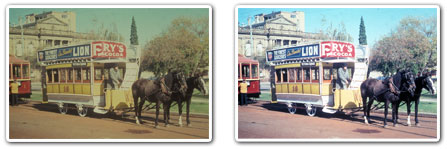
A colour restoration will produce a more natural looking image (click to enlarge)
(Image courtesy of the National Trust of South Australia)
Some images can suffer from fading over time or the production process has left them tinted. These can be restored back to more natural looking images with a good digital colour restoration.

Compare the green tint of this medium format negative
to the restored version on the right
Older photos, slides and negatives benefit more from colour restoration than modern photos do. This is generally due to modern cameras having quite good ‘Auto’ settings which produce good colour and balance. Often an automatic colour restoration will have the opposite effect and leave the image looking unnatural, although smaller adjustments can be made in a program like Photoshop to good effect. You will also get great results when dealing with old black and white images which are faded, stained or sepia (older photographs chemically treated either for visual effect or for archival purposes), with a colour restoration bringing them back to true black and white.
Digital ICE Technology:
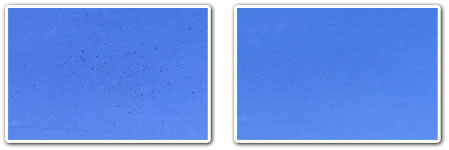
Compare the artifacts engrained in the image (left) to the clear, restored image on the right
(click for full comparison)
Digital ICE (Image Correction and Enhancement) is a technology used to detect and correct dust and scratches on images and is applied from within the scanner. Even images stored correctly may be dusty or have artifacts and scratches engrained in them, and when scanning at high resolutions, a tiny speck of dust suddenly becomes a huge problem! ICE technology is very effective for an automated restoration feature, although scanning time can be drastically increased (up to 5x longer depending on the image and resolution) and it sometimes will ‘eat’ into the image mistaking things such as a detailed section or outlines of people for scratches.
Manual Image Restoration:
If the image needs very close attention, nothing beats professional manual restoration in a program like Adobe Photoshop. Using various tools within the program all sorts of detailed colour balancing and artifact removal can be undertaken as well as being able to re-create content that doesn’t even exist (think of a torn or an old, completely degraded photo). This is the ultimate in photo restoration but is very time consuming and generally takes a skilled operator to achieve the best results.

Having to re-create something that doesn’t exist is time consuming, but definitely possible!
(click to enlarge)
There are so many good reasons to bring your old images into the digital age so they are safe for generations to come and for family and friends to enjoy. Take advantage of some of the great scanning technologies available, and whether you scan them yourself or take them to a professional, you’ll be glad you did.
It’s never too soon to start preserving your images, and it may already be too late, so if you’re wondering what to do with your old albums, don’t throw them away, it’s time to act and have them digitised and restored today!
We also have some tips on storing your slides and negatives safely. Please reply below if you have any comments or questions.
Happy Scanning 
– Gareth

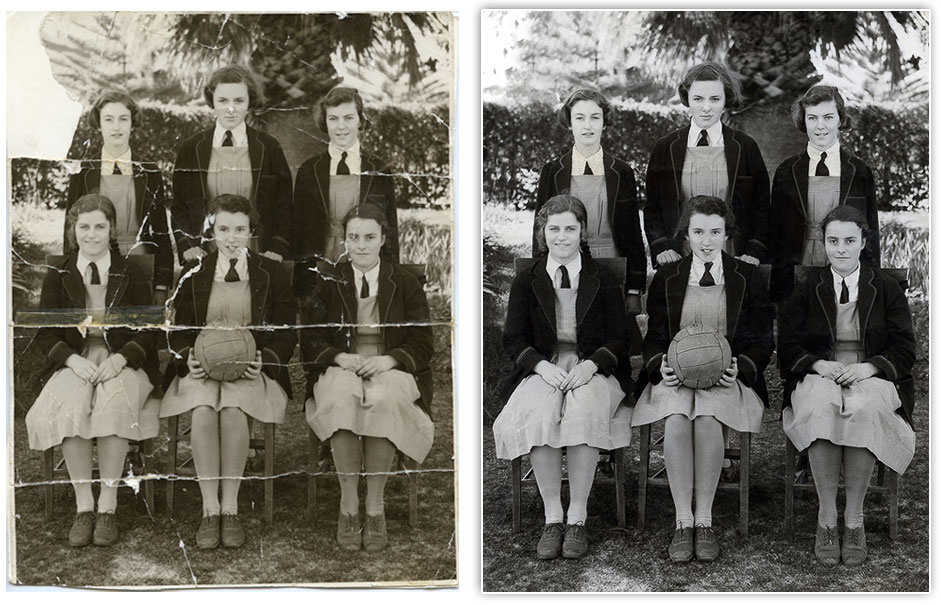






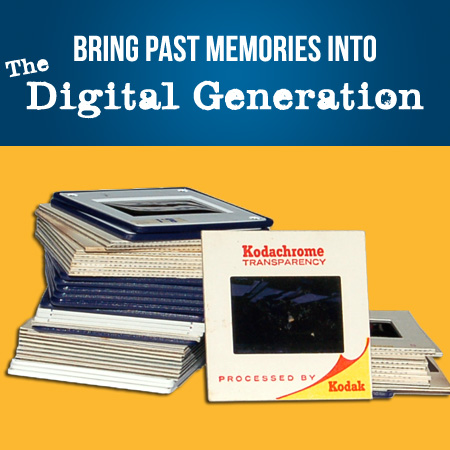
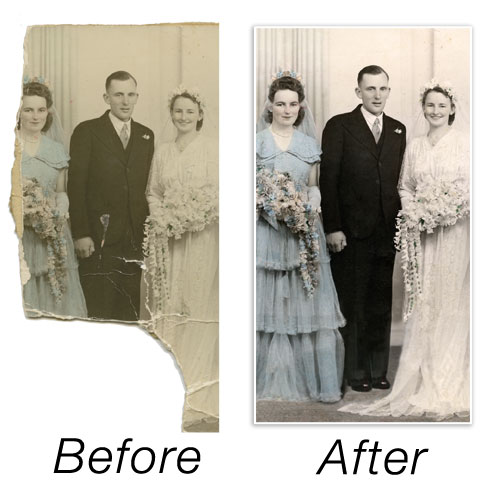

Thank you for such an informed email. Very interesting and clearly presented.
Your info is very well presented, Unfortunately however when people read things of this nature, it usually goes in one ear and out the other!!
They don’t realize that images will deteriorate over time, so it’s important to protect them as best we can, or restore if need be..
Very informative thanks……. Will link to this site in the future on my site……